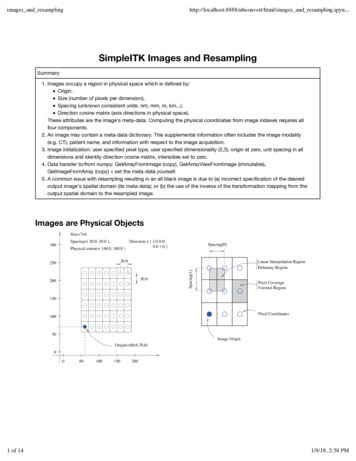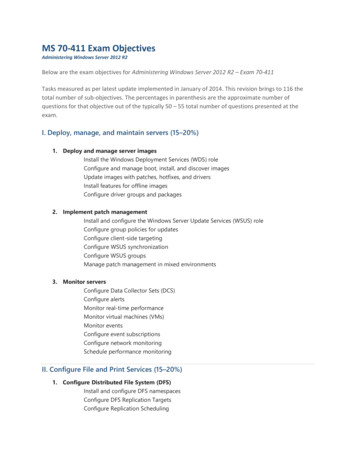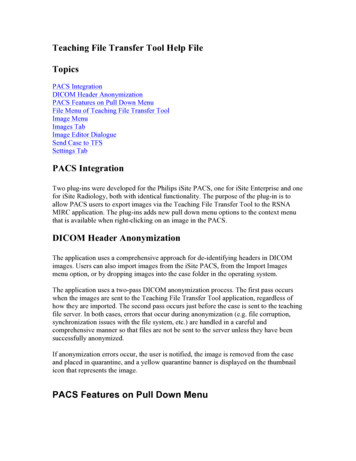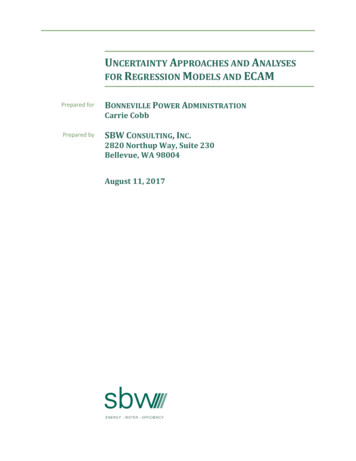
Transcription
images and ges and resampling.ipyn.SimpleITK Images and ResamplingSummary:1. Images occupy a region in physical space which is defined by:Origin.Size (number of pixels per dimension).Spacing (unknown consistent units: nm, mm, m, km.).Direction cosine matrix (axis directions in physical space).These attributes are the image's meta-data. Computing the physical coordinates from image indexes requires allfour components.2. An image may contain a meta-data dictionary. This supplemental information often includes the image modality(e.g. CT), patient name, and information with respect to the image acquisition.3. Image initialization: user specified pixel type, user specified dimensionality (2,3), origin at zero, unit spacing in alldimensions and identity direction cosine matrix, intensities set to zero.4. Data transfer to/from numpy: GetArrayFromImage (copy), GetArrayViewFromImage (immutable),GetImageFromArray (copy) set the meta-data yourself.5. A common issue with resampling resulting in an all black image is due to (a) incorrect specification of the desiredoutput image's spatial domain (its meta-data); or (b) the use of the inverse of the transformation mapping from theoutput spatial domain to the resampled image.Images are Physical Objects1 of 141/9/18, 2:38 PM
images and ges and resampling.ipyn.Pixel TypesThe pixel type is represented as an enumerated type. The following is a table of the enumerated list.sitkUInt8Unsigned 8 bit integersitkInt8Signed 8 bit integersitkUInt16Unsigned 16 bit integersitkInt16Signed 16 bit integersitkUInt32Unsigned 32 bit integersitkInt32Signed 32 bit integersitkUInt64Unsigned 64 bit integersitkInt64Signed 64 bit integersitkFloat3232 bit floatsitkFloat6464 bit floatsitkComplexFloat32 complex number of 32 bit floatsitkComplexFloat64 complex number of 64 bit floatsitkVectorUInt8Multi-component of unsigned 8 bit integersitkVectorInt8Multi-component of signed 8 bit integersitkVectorUInt16Multi-component of unsigned 16 bit integersitkVectorInt16Multi-component of signed 16 bit integersitkVectorUInt32Multi-component of unsigned 32 bit integersitkVectorInt32Multi-component of signed 32 bit integersitkVectorUInt64Multi-component of unsigned 64 bit integersitkVectorInt64Multi-component of signed 64 bit integersitkVectorFloat32Multi-component of 32 bit floatsitkVectorFloat64Multi-component of 64 bit floatsitkLabelUInt8RLE label of unsigned 8 bit integerssitkLabelUInt16RLE label of unsigned 16 bit integerssitkLabelUInt32RLE label of unsigned 32 bit integerssitkLabelUInt64RLE label of unsigned 64 bit integersThere is also sitkUnknown, which is used for undefined or erroneous pixel ID's.Some filters only work with images with a specific pixel type. The primary example is the registration framework which workswith sitkFloat32 or sitkFloat64. To address this issue you can either specify the appropriate pixel type when reading orcreating the image, or use the Cast function k 1 1simple.html#af8c9d7cc96a299a05890e9c3db911885).2 of 141/9/18, 2:38 PM
images and ges and resampling.ipyn.In [1]: import SimpleITK as sitkimport numpy as npimport osfrom ipywidgets import interact, fixedimport matplotlib.pyplot as plt%matplotlib inlinefrom downloaddata import fetch data as fdataOUTPUT DIR 'output'Image CreationThe following components are required for a complete definition of an image:1. Pixel type [fixed on creation, no default]: unsigned 32 bit integer, sitkVectorUInt8, etc., see list above.2. Sizes [fixed on creation, no default]: number of pixels/voxels in each dimension. This quantity implicitly defines theimage dimension.3. Origin [default is zero]: coordinates of the pixel/voxel with index (0,0,0) in physical units (i.e. mm).4. Spacing [default is one]: Distance between adjacent pixels/voxels in each dimension given in physical units.5. Direction matrix [default is identity]: mapping, rotation, between direction of the pixel/voxel axes and physicaldirections.Initial pixel/voxel values are set to zero.In [2]: image 3D sitk.Image(256, 128, 64, sitk.sitkInt16)image 2D sitk.Image(64, 64, sitk.sitkFloat32)image RGB sitk.Image([128,64], sitk.sitkVectorUInt8, 3)sitk.Show(image 3D)sitk.Show(image RGB)Or, creation from file.In [3]: logo sitk.ReadImage(fdata('SimpleITK.jpg'))# GetArrayViewFromImage returns an immutable numpy array view to the lt.axis('off');Fetching SimpleITK.jpg3 of 141/9/18, 2:38 PM
images and ges and resampling.ipyn.Basic Image Attributes (Meta-Data)You can change the image origin, spacing and direction. Making such changes to an image already containing data shouldbe done cautiously.In [4]: selected image image 3Dprint('Before modification:')print('origin: ' str(selected image.GetOrigin()))print('size: ' str(selected image.GetSize()))print('spacing: ' str(selected image.GetSpacing()))print('direction: ' str(selected image.GetDirection()))print('pixel type: ' str(selected image.GetPixelIDTypeAsString()))print('number of pixel components: ' str(selected image.GetNumberOfComponentsPerPixel()))selected image.SetOrigin((78.0, 76.0, 77.0))selected image.SetSpacing([0.5,0.5,3.0])print('\nAfter modification:')print('origin: ' str(selected image.GetOrigin()))print('spacing: ' str(selected image.GetSpacing()))Before modification:origin: (0.0, 0.0, 0.0)size: (256, 128, 64)spacing: (1.0, 1.0, 1.0)direction: (1.0, 0.0, 0.0, 0.0, 1.0, 0.0, 0.0, 0.0, 1.0)pixel type: 16-bit signed integernumber of pixel components: 1After modification:origin: (78.0, 76.0, 77.0)spacing: (0.5, 0.5, 3.0)Accessing Pixels and SlicingEither use the GetPixel and SetPixel functions or the Pythonic slicing operator. The access functions and image slicingoperator are in [x,y,z] order.In [5]: print(image 3D.GetPixel(0, 0, 0))image 3D.SetPixel(0, 0, 0, 1)print(image 3D.GetPixel(0, 0, 0))# This can also be done using Pythonic notation.print(image 3D[0,0,1])image 3D[0,0,1] 2print(image 3D[0,0,1])01024 of 141/9/18, 2:38 PM
images and ges and resampling.ipyn.In [6]: # Brute force sub-samplinglogo subsampled logo[::2,::2]# Get the sub-image containing the word Simplesimple logo[0:115,:]# Get the sub-image containing the word Simple and flip itsimple flipped logo[115:0:-1,:]n .imshow(sitk.GetArrayViewFromImage(logo iewFromImage(simple flipped))plt.axis('off');Image operationsSimpleITK supports basic arithmetic operations between images while taking into account their meta-data. Images mustphysically overlap (pixel by pixel).How close do physical attributes (meta-data values) need to be in order to be considered equivalent?5 of 141/9/18, 2:38 PM
images and ges and resampling.ipyn.In [7]: img width 128img height 64img1 sitk.Image((img width, img height), sitk.sitkUInt8)for i in range(img width):img1[i,1] 5img2 sitk.Image(img1.GetSize(), g2.SetOrigin([0.000001,0.000001])for i in range(img width):img2[i,1] 120img2[i,img height//2] 60img3 img1 img2plt.imshow(sitk.GetArrayViewFromImage(img3), cmap plt.cm.Greys r)plt.axis('off');Comparative operators ( , , , , ) are also supported, returning binary images.In [8]: thresholded image img3 d image), cmap plt.cm.Greys r)plt.axis('off');6 of 141/9/18, 2:38 PM
images and ges and resampling.ipyn.SimpleITK2Numpy and Numpy2SimpleITKSimpleITK and numpy indexing access is in opposite order!SimpleITK: image[x,y,z]numpy: image numpy array[z,y,x]SimpleITK2Numpy1. GetArrayFromImage(): returns a copy of the image data. You can then freely modify the data as it has no effecton the original SimpleITK image.2. GetArrayViewFromImage(): returns a view on the image data which is useful for display in a memory efficientmanner. You cannot modify the data and the view will be invalid if the original SimpleITK image is deleted.Numpy2SimpleITK1. GetImageFromArray(): returns a SimpleITK image with origin set to zero, spacing set to one for all dimensions,and the direction cosine matrix set to identity. Intensity data is copied from the numpy array. In most cases youwill need to set appropriate meta-data values.In [9]: nda sitk.GetArrayFromImage(image 3D)print(image 3D.GetSize())print(nda.shape)nda sitk.GetArrayFromImage(image RGB)print(image RGB.GetSize())print(nda.shape)(256, 128, 64)(64, 128, 256)(128, 64)(64, 128, 3)In [10]: gabor image sitk.GaborSource(size [64,64], frequency .03)# Getting a numpy array view on the image data doesn't copy the datanda view sitk.GetArrayViewFromImage(gabor image)plt.imshow(nda view, cmap plt.cm.Greys r)plt.axis('off');7 of 141/9/18, 2:38 PM
images and ges and resampling.ipyn.In [11]: nda np.zeros((10,20,3))#if this is supposed to be a 3D gray scale image [x 3, y 20, z 10]img sitk.GetImageFromArray(nda)print(img.GetSize())#if this is supposed to be a 2D color image [x 20,y 10]img sitk.GetImageFromArray(nda, isVector True)print(img.GetSize())(3, 20, 10)(20, 10)Reading and WritingSimpleITK can read and write images stored in a single file, or a set of files (e.g. DICOM series). The toolkit provides both anobject oriented and a procedural interface. The primary difference being that the object oriented approach provides morecontrol while the procedural interface is more convenient.We look at DICOM images as an example illustrating this difference. Images stored in the DICOM format have a meta-datadictionary associated with them, which is populated with the DICOM tags. When a DICOM image series is read as a singleimage volume, the resulting image's meta-data dictionary is not populated since DICOM tags are specific to each of the filesin the series. If you use the procedural method for reading the series then you do not have access to the set of meta-datadictionaries associated with each of the files. To obtain each dictionary you will have to access each of the files separately.On the other hand, if you use the object oriented interface, the set of dictionaries will be accessible from theImageSeriesReader which you used to read the DICOM series. The meta-data dictionary for each file is available usingthe HasMetaDataKey (https://itk.org/SimpleITKDoxygen/html/classitk 1 1simple 1 6514b6d) and classitk 1 1simple 1 d8c30ee) methods.We start with reading and writing an image using the procedural interface.In [12]: img age(img, os.path.join(OUTPUT DIR, 'SimpleITK.png'))Fetching SimpleITK.jpgRead an image in JPEG format and cast the pixel type according to user selection.8 of 141/9/18, 2:38 PM
images and ges and resampling.ipyn.In [13]: # Several pixel types, some make sense in this case (vector types) and some are just show# that the user's choice will force the pixel type even when it doesn't make sense.pixel types { 'sitkVectorUInt8' : sitk.sitkVectorUInt8,'sitkVectorUInt16' : sitk.sitkVectorUInt16,'sitkVectorFloat64' : sitk.sitkVectorFloat64}def pixel type dropdown callback(pixel type, pixel types dict):#specify the file location and the pixel type we wantimg sitk.ReadImage(fdata('SimpleITK.jpg'), pixel types dict[pixel lt.axis('off')interact(pixel type dropdown callback, pixel type list(pixel types.keys()), pixeltypes dict fixed(pixel types));Fetching SimpleITK.jpgvector of 8-bit unsigned integer(255, 255, 255)Read a DICOM series and write it as a single mha file.In [14]: data directory os.path.dirname(fdata("CIRS057A MR CT DICOM/readme.txt"))series ID 515'# Use the functional interface to read the image series.original image sitk.ReadImage(sitk.ImageSeriesReader GetGDCMSeriesFileNames(data directory,series ID))# Write the image.output file name 3D os.path.join(OUTPUT DIR, '3DImage.mha')sitk.WriteImage(original image, output file name 3D)Fetching CIRS057A MR CT DICOM/readme.txtSelect a specific DICOM series from a directory and only then load user selection.9 of 141/9/18, 2:38 PM
images and ges and resampling.ipyn.In [15]: data directory os.path.dirname(fdata("CIRS057A MR CT DICOM/readme.txt"))# Global variable 'selected series' is updated by the interact functionselected series ''def DICOM series dropdown callback(series to load, series dictionary):global selected series# Print some information about the series from the meta-data dictionary# DICOM standard part 6, Data Dictionary: ut/pdf/part06.pdfimg sitk.ReadImage(series dictionary[series to load][0])tags to print {'0010 0010': 'Patient name: ','0008 0060' : 'Modality: ','0008 0021' : 'Series date: ','0008 0080' : 'Institution name: ','0008 1050' : 'Performing physician\'s name: '}for tag in tags to print:try:print(tags to print[tag] img.GetMetaData(tag))except: # Ignore if the tag isn't in the dictionarypassselected series series to load# Directory contains multiple DICOM studies/series, store# in dictionary with key being the series IDseries file names {}series IDs sitk.ImageSeriesReader GetGDCMSeriesIDs(data directory)# Check that we have at least one seriesif series IDs:for series in series IDs:series file names[series] sitk.ImageSeriesReader GetGDCMSeriesFileNames(data directory, series)interact(DICOM series dropdown callback, series to load list(series IDs), series dictionary fixed(series file names));else:print('Data directory does not contain any DICOM series.')Patient name: testPerforming physician's name:Institution name: Childrens National Medical CtrSeries date: 20140502Modality: CT10 of 141/9/18, 2:38 PM
images and ges and resampling.ipyn.In [16]: img sitk.ReadImage(series file names[selected series])# Display the image slice from the middle of the stack, z axisz mage(img)[z,:,:], cmap plt.cm.Greys r)plt.axis('off');Write the volume as a series of JPEGs. The WriteImage function receives a volume and a list of images names and writes thevolume according to the z axis. For a displayable result we need to rescale the image intensities (default is [0,255]) since theJPEG format requires a cast to the UInt8 pixel type.In [17]: g), sitk.sitkUInt8),[os.path.join(OUTPUT DIR, 'slice{0:03d}.jpg'.format(i)) for i inrange(img.GetSize()[2])])11 of 141/9/18, 2:38 PM
images and ges and resampling.ipyn.ResamplingfmResampling as the verb implies is the action of sampling an image, which itself is a sampling of an original continuous signal.Generally speaking, resampling in SimpleITK involves four components:1. Image - the image we resample, given in coordinate system m .2. Resampling grid - a regular grid of points given in coordinate system f which will be mapped to coordinate systemm.3. Transformation Tfm - maps points from coordinate system f to coordinate system m , m p Tfm (f p).4. Interpolator - method for obtaining the intensity values at arbitrary points in coordinate system m from the values ofthe points defined by the Image.While SimpleITK provides a large number of interpolation methods, the two most commonly used are sitkLinear andsitkNearestNeighbor. The former is used for most interpolation tasks, a compromise between accuracy andcomputational efficiency. The later is used to interpolate labeled images representing a segmentation, it is the onlyinterpolation approach which will not introduce new labels into the result.SimpleITK's procedural API provides three methods for performing resampling, with the difference being the way you specifythe resampling grid:1. Resample(const Image &image1, Transform transform, InterpolatorEnum interpolator,double defaultPixelValue, PixelIDValueEnum outputPixelType)2. Resample(const Image &image1, const Image &referenceImage, Transform transform,InterpolatorEnum interpolator, double defaultPixelValue, PixelIDValueEnumoutputPixelType)3. Resample(const Image &image1, std::vector uint32 t size, Transform transform,InterpolatorEnum interpolator, std::vector double outputOrigin, std::vector double outputSpacing, std::vector double outputDirection, double defaultPixelValue,PixelIDValueEnum outputPixelType)12 of 141/9/18, 2:38 PM
images and ges and resampling.ipyn.In [18]: def resample display(image, euler2d transform, tx, ty, theta):euler2d transform.SetTranslation((tx, ty))euler2d transform.SetAngle(theta)resampled image sitk.Resample(image, euler2d led image))plt.axis('off')plt.show()euler2d sitk.Euler2DTransform()# Why do we set the interact(resample display, image fixed(logo), euler2d transform fixed(euler2d), tx (-128.0, 128.0,2.5), ty (-64.0, 64.0), theta (-np.pi/4.0,np.pi/4.0));Common ErrorsIt is not uncommon to end up with an empty (all black) image after resampling. This is due to:1. Using wrong settings for the resampling grid, not too common, but does happen.2. Using the inverse of the transformation Tfm . This is a relatively common error, which is readily addressed byinvoking the transformations GetInverse method.Defining the Resampling GridIn the example above we arbitrarily used the original image grid as the resampling grid. As a result, for many of thetransformations the resulting image contained black pixels, pixels which were mapped outside the spatial domain of theoriginal image and a partial view of the original image.If we want the resulting image to contain all of the original image no matter the transformation, we will need to define theresampling grid using our knowledge of the original image's spatial domain and the inverse of the given transformation.Computing the bounds of the resampling grid when dealing with an affine transformation is straightforward. An affinetransformation preserves convexity with extreme points mapped to extreme points. Thus we only need to apply the inversetransformation to the corners of the original image to obtain the bounds of the resampling grid.Computing the bounds of the resampling grid when dealing with a BSplineTransform or DisplacementFieldTransform is moreinvolved as we are not guaranteed that extreme points are mapped to extreme points. This requires that we apply theinverse transformation to all points in the original image to obtain the bounds of the resampling grid.13 of 141/9/18, 2:38 PM
images and ges and resampling.ipyn.In [19]: euler2d sitk.Euler2DTransform()# Why do we set the tx 64ty 32euler2d.SetTranslation((tx, ty))extreme points oint((0,logo.GetHeight()))]inv euler2d euler2d.GetInverse()extreme points transformed [inv euler2d.TransformPoint(pnt) for pnt in extremepoints]min x min(extreme points transformed)[0]min y min(extreme points transformed, key lambda p: p[1])[1]max x max(extreme points transformed)[0]max y max(extreme points transformed, key lambda p: p[1])[1]# Use the original spacing (arbitrary decision).output spacing logo.GetSpacing()# Identity cosine matrix (arbitrary decision).output direction [1.0, 0.0, 0.0, 1.0]# Minimal x,y coordinates are the new origin.output origin [min x, min y]# Compute grid size based on the physical size and spacing.output size [int((max x-min x)/output spacing[0]), int((max y-min y)/output spacing[1])]resampled image sitk.Resample(logo, output size, euler2d, sitk.sitkLinear, output origin, output spacing, output sampled image))plt.axis('off')plt.show()Are you puzzled by the result? Is the output just a copy of the input? Add a rotation to the code above and see whathappens (euler2d.SetAngle(0.79)).(data augmentation.ipynb)Next » (data augmentation.ipynb)14 of 141/9/18, 2:38 PM
In [1]: import SimpleITK as sitk import numpy as np import os from ipywidgets import interact, fixed import matplotlib.pyplot as plt %matplotlib inline from downloaddata import fetch_data as fdata OUTPUT_DIR 'output' Image Creation










